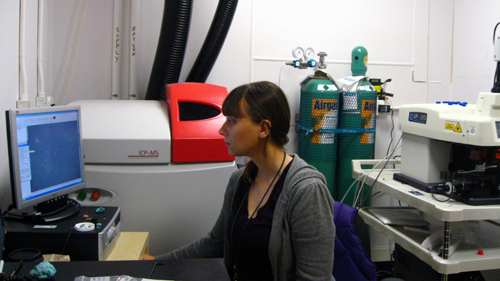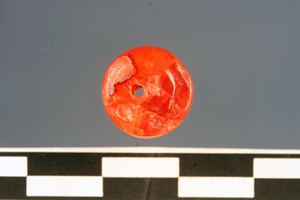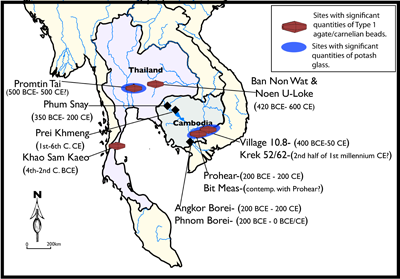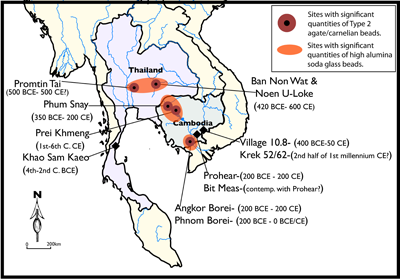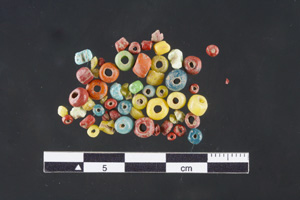Cyler Conrad interviews Alison Carter
Cyler: Alison, congratulations on your recent publication in the Cambridge Archaeological Journal! This paper, based on your dissertation research focusing on beads, is quite exciting. What do you see as significant contributions of your work to SEA archaeology?
Alison: I think one strength of this work is looking at stone and glass beads together. There have been several excellent studies of glass beads (by Lankton and Dussubieux) and stone beads (by Bellina and Theunissen) discussing changes in bead types over time, and I certainly drew heavily from the work of these scholars. However, by looking at stone and glass beads together I think we can see larger patterns related to socio-political and economic changes happening in SEA during the early first millennium CE. In order to identify these different bead types I was looking at stone and glass beads in a few ways. For the agate/carnelian and garnet stone beads, I was looking at their shape and morphology, and how they were produced, including how they were drilled. Most of the glass beads were drawn beads (frequently referred to as Indo-Pacific beads) and there was not much morphological difference. So, compositional analysis using laser-ablation inductively-coupled plasma-mass spectrometry (LA-ICP-MS) was needed in order to identify the recipes used and distinguish between glass bead types. I used LA-ICP-MS on the stone beads as well, in order to determine where the stone came from. For the agate/carnelian beads, these appear to derive primarily from Indian Deccan Traps raw material sources (a publication on this is currently in preparation). I have not found the source for the garnet beads, but one set found at Angkor Borei seems most similar to beads coming from South Asia, while another set found primarily in southeast Cambodia was likely locally produced (this is also detailed in another forthcoming publication, but also discussed in Carter 2012).
Cyler: What do you see as the important regional changes then, and how do they relate to the bead evidence?
Alison: What I think we’re seeing is that in the first few centuries CE, there is a shift to mass production of glass and stone beads and this becomes materialized through expanding bead exchange networks. I argue that the increased availability of these objects may have allowed for their use as part of elite power maintenance strategies. I hypothesize that this may have been driven in part by growing elite power in the Mekong Delta, because we know archaeologically and historically that this was becoming an important place on the landscape during this period. The Mekong Delta was a major trading center, so it seems likely that elites in this region would control the exchange of prestige objects, like beads. This is a hypothesis that needs further testing, and certainly other places in SEA, like the Dong Son region in northern Vietnam and areas of central Thailand, were becoming more socio-politically centralized during this period as well.
The increase in the quantity of beads coincides with a period of intensified trade with South Asia (as identified by Bellina and Glover). However, through study of beads, we can also see the persistence of smaller regional exchange of specific bead types. Some types, like garnet beads, may have been locally made and important markers of identity. So, while the exchange of agate/carnelian and glass beads were generally becoming more regional, other bead types were exchanged in localized networks.
Cyler: Wow…very cool! Where do you see SEA bead research headed in the future?
Alison: What I hope new studies of beads will do is not just identify the bead types found at certain sites, but start to examine critically how beads were being used by Southeast Asian people. We frequently consider beads (especially agate/carnelian beads) to be prestige objects and beads are overwhelmingly found in burial contexts. This means that with careful study we can start looking at issues of identity and status. I think there are some very interesting questions regarding emerging social stratification or possible differences in age or gender that could be examined. Not everyone in a community was buried with beads. Are there any patterns in the age/gender of individuals who are buried with beads, and especially those buried with a lot of beads? What role did people with beads play within communities? How was it that people acquired so many beads? For example, at Khok Phanom Di, the “princess” burial is believed to have acquired or received many shell beads because of her skill as a potter. Does a similar pattern hold in the early first millennium CE or might people acquire beads in another way? Are beads really considered to be prestige objects, or are there examples where beads may not have been markers of status?
Cyler: Any future plans for bead research?I also think the data on glass and stone beads could be integrated with studies of other bead types – metal and shell – and this might provide even more information about connections between sites, localized exchange networks etc.
Alison: I grew up around beads, I worked in two different bead stores in high school and college, and have always found them to be fascinating. I have a few small projects looking at bead collections from specific sites. I’ve started to collate SEA bead data in order to think about issues regarding beads and identity, as I mentioned above. Even though I also have a new separate project (household archaeology in Angkor) I usually can’t say no when people ask me to look at their beads; they won’t ever stop being interesting to me!
Cyler: Thank you, Alison. I hope all of our ISEAA followers will enjoy this recent publication by Alison Carter on beads in SEA! Please contact Alison ([email protected]) for a copy of this paper if you do not have institutional access.
Carter, A. 2012, Garnet Beads in Southeast Asia: Evidence for Local Production? in D Bonatz, A Reinecke & Tjoa-Bonatz (eds), Proceedings of the EurASEAA13 conference in Berlin. NUS, Singapore, pp. 296-306.

